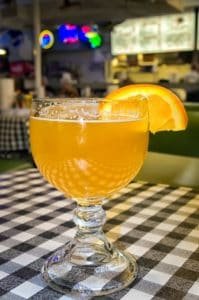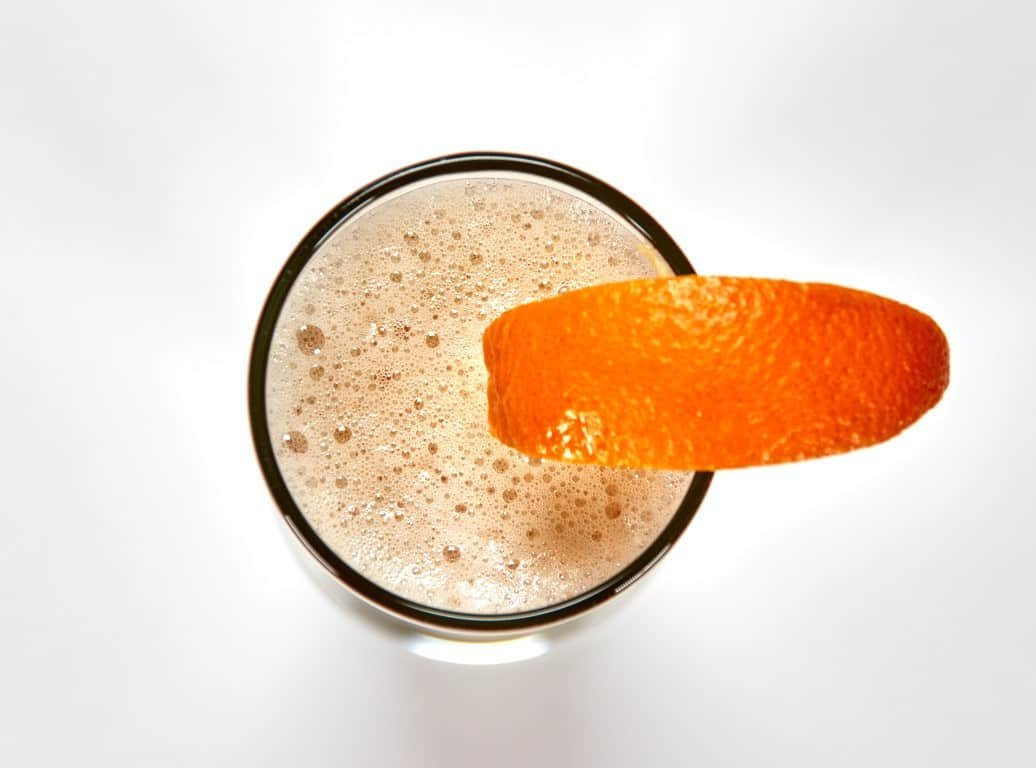Today lots of popular beers have an orange flavor. Orange and craft beer go really well together. But as a brewer, have you ever tried adding orange flavor into your beer? All you are doing is adding orange zest or orange peel to your beer. It is very easy, but like a lot of things, timing is everything. So when is the best time to add orange peel to your beer?
The best time to add orange to beer is in the last 5 minutes of the boil. Some brewers will say that you can do it in the last 10 minutes of the boil, but I find better results in the last 5 minutes. sometime in the last 2 or 3 minutes.
Alternatively, you can add the zest near the end of fermentation as well. Depending on your taste, you might like one way more than the other. So experimenting is a good idea.
I will go over what can happen if you add the orange flavor at the wrong time, some tips on what kind of oranges to use, and I will also include a simple orange beer recipe below for you to try.

What happens when you add orange at the wrong time?
If you add orange peel a the beginning of the boil, you are essentially boiling it for 60 minutes, which is not a good idea. The longer one leaves something like that in the boil, the more likely it would be to extract bitter elements from the peel, and the volatile oils would evaporate out.
This is the opposite effect you are looking for. Your beer will become more bitter than sweet, and would be hard to consume. I say a 5 minute boil or adding after fermentation is the best options.
Are all oranges similar?
Before we begin adding orange flavor into your homemade brew, it’s essential to know the type of orange you’ll be using. There are two significant groups of oranges, that is to say, Bitter Oranges and Sweet Oranges. We shall look into each of them and dig into their difference while determining if they can affect your beer flavor.
Bitter Oranges
Scientifically known as Citrus Aurantium and it’s a vast class that provides herbal and citric overtones. At times, they are called Seville oranges, not many people like eating its flesh, but the peel can provide the best aroma and flavor that you can add to your homemade beer for the best oranges flavor.
There is another type of bitter oranges scientifically known as Citrus Aurantium var. Currassuviencis. Mostly it was found on the Caribbean Island (Curacao). Spanish explorers planted these types of bitter oranges in the 1500s, and they have adapted to the Island environment. Some people call it Iaraha fruit but the flesh is inedible; however, the peel offers the best aromatic.
Sweet Oranges (Citrus Sinensis)
These are the typical type of sweet oranges with tasty juice that you usually find in the supermarket. When you add sweet oranges to your beer, you will likely get the best flavor that’s easily identifiable compared to the bitter oranges. Valencia (Citrus Sinensis var._ Valencia_) Is a typical member of the Citrus Sinensis family.
If you’ve ever tasted the Blue Moon Belgian White, then that’s the exact flavor and aroma we are referring to. You always have a choice to purchase fresh fruits and peel off the zest or but the dried oranges from your local store. In either way, you will still get the best results.
In summary, you can choose sweet orange peel if you need intense orange flavor or buy bitter orange peel if you prefer pleasant citrusy character.
How to add orange flavor to beer when brewing
This section shall cover the most straightforward recipe that will guide through making your bear at home and add orange flavor. It’s a recipe for 10 liters, so some machinery will be necessary to accomplish the task. What we shall require includes large cooking pots, muslin cloth, leger colander, thermometer, sterilized fermenting bucket, and hydrometer.
Other ingredients
- 100g brown sugar
- Zest obtained from one orange ( it can be sweet or bitter)
- 1 sachet of ale yeast
- I tablespoon of carrageen/Irish moss
- 15g of East Kent Goldings hops
- 2kg of crushed pale ale malt
Procedure
The initial stage involves heating 7 liters of water in the pot you prepared up to 76 degrees Celsius. Your thermometer should help you measure the temperature accurately. Once the water has attained the temperature, turn off the heat. Now, we shall get to the next step where we shall make the mash. So, you add the malt to the water on the pot, stir it up, and by the end, it will get to 66 degrees Celsius. So, cover the pot for one-hour 15 minutes to retain the heat .
As you wait for the 75 minutes to elapse, heat another 12 liters of water to attain 72-80 degrees Celsius. Assuming the 75 minutes have elapsed, you’ll need to stain your liquor(wort) into another pot using a colander and a muslin cloth. When done, don’t interfere with the colander.
It’s time to use the 12 liters of water you had boiled. Use a jug to pour the heated water through the grains to extract flavor and sugar in them. If you don’t have a big pot, then you can suspend the colander to allow the liquid to pass. After the sample has cooled, it should have a gravity of 1.038.
Now, we shall boil the wort again and, in the process, add 5 grams of sugar and hops. Heating should take 1hr 15 minutes, and the lid should be on. After 1hr 15min, this is now the time you have been waiting for, a chance to make your beer look tremendous and with fruity flavor. So, we shall add carrageen, 5g of hops, and the orange zest you had collected.
Even though you can use dry orange fruit to make the zest, we suggest you get a flesh fruit. With fresh orange, the aroma will be pleasing. Using the right tool, you don’t have to buy packed zest from the supermarket; you can make yours at home, peel off the cover off the back of the orange, and don’t get to the whitish part.
After adding the stated items, you need to boil for 10 minutes. After that, you add the remaining 5g of hopes again, then simmer for another 5 minutes and sand for 40minutes. At this stage, we will pour the wort through a muslin cloth or fine sterilized sieve into a fermenting bucket. However, the bucket should rest on a sink surrounded by ice and water to speed up the cooling process.
Next, you should confirm the gravity if it’s 1.0421. After the worth has cooled, add yeast then cover to allow the fermentation process to take place. The temperature should be maintained for 20 degrees Celsius for about four days. Every day you check, you should see some pretty foam formed at the top. On the fifth day, the gravity should be 1.007, and you’ll not see the foam as it shall have cleared.
You are a step away from making your best orange flavored beer. All you need to do is siphon the beer into the bottle and add ¼ teaspoon of sugar in every bottle. The sugar will help condition the beer; in 10 days, you can organize a party and share your homemade orange flavored beer.
What beer style works with the orange peel?
Above, we talked about How to add orange flavor to beer when brewing. In this section, we shall look at the standard beer style that can work with orange flavor. We would say that orange peel can be added to any beer style, but there is always a limitation. So, if you have some beer already at home, and you want to improve the flavor, then you can still use the orange taste, whether its sweet orange or bitter orange.
Flavored or lighter-bodied beers are ideal for orange peel. This beer style includes ordinary, bitter, light American lager, Blonde Ale, and Australian sparkling Ale. However, you are not limited; wheat beers can also prove to be useful. You’ll find Witbier, Berliner Weisse, Dunkles Weissbier, Weizenbock, and American Wheat Beer under the category.
Some beers come in citrusy hop flavor, adding orange taste to it improves the aroma. Ordinary beer with citrusy hop flavor includes English IPAs, Belgian IPAs, and American IPAs. However, individual beer styles have darker and roast types, including Oatmeal Stout, Baltic Porter, and Oatmeal Stout can also work with orange peel.
When using these kinds of beer, you won’t have a hard time adding the orange flavor. Forts, you can add at flameout or when it’s nearing the end of the boiling point.
Conclusion
If you love the aroma and the taste that comes with orange, then you’ll have a reason to make your beer with orange flavor at home. Spare your time and be patients; you can always make it. Like I said, you might have to experiment to get the flavor that is right for you. People will have their own opinion on what they like and don’t like.
Recent Posts
Does Bud Light Seltzer Taste Like Beer? - Unveiling the Flavor Profile
The popularity of hard seltzers has risen dramatically in recent years, with an increasing number of consumers seeking a lighter, refreshing alternative to traditional alcoholic beverages. Bud Light...
How to Flavor Moonshine with Extract: Tips and Tricks for a Delicious Batch
Moonshine, a homemade distilled spirit, has a reputation for its strong flavor and robust alcohol content. Many people find the taste too harsh to enjoy on its own, which is why flavoring moonshine...

